The options that you can configure from the PowerCOBOL Project Manager have been extended. The following sections describe the new options.
You display the project options by selecting Options from the Tool menu. Project Manager now displays a dialog with six tabs: Project, Build, Design, Form, Editor, Debug. The Project tab contains the project options as in earlier releases; the other tabs contain new Project Manager options.
The figure below shows the Project Options tab:
Figure 2.10 Project Option Properties
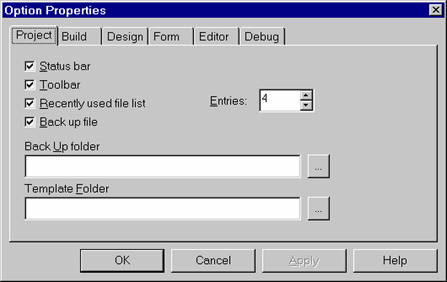
Where:
Turns on/off the status bar displayed at the bottom of the Project Manager Window
Turns on/off the Project Manager toolbar
Turns on/off the display of the most recently access .ppj files in the File pull down menu
Activates/deactivates the automatic project backup (.ppj~ file will represent the previous version of the project)
Specifies the path where you want the back up version of the project placed. If left blank, it will be placed in the same folder that the project was loaded from.
Specifies the path of the folder containing the template projects. If left blank, it points to the default template folder (C:\Program Files\Fujitsu NetCOBOL for Windows\COBOL\STDTMPLT\)
The figure below shows the Build tab:
Figure 2.11 Build Option Properties
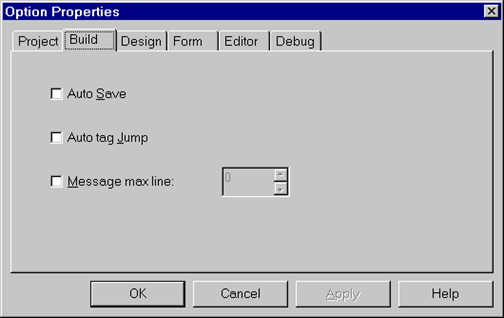
Where:
Specifies whether to save projects automatically before you build them.
If you check this option, the build-time message asking you to confirm whether the project should be saved is not displayed.
Specifies whether PowerCOBOL should automatically display the first line of code containing an error if a build error was caused by a coding error.
If you check this option PowerCOBOL opens the editor at the first line containing an error when the build finishes.
Specifies whether to stop the build when a specified number of error messages have been displayed.
If you check this option the build is interrupted when the number of error messages reaches the number specified.
The figure below shows the Design tab:
Figure 2.12 Design Option Properties
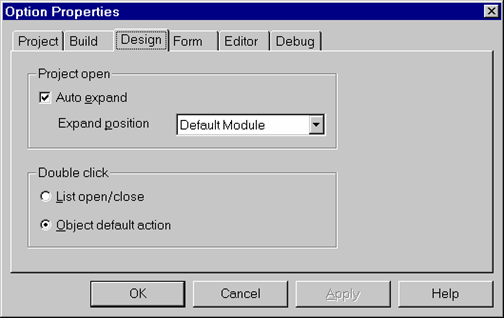
Where:
Specifies whether or not the Project Manager should automatically expand the tree hierarchy displayed in the left windowpane when a project is initially opened. If this box is checked (on), then the selection in the Expand position drop down list will be used to determine what level in the hierarchy to expand to.
Specifies the behavior when you double-click on an item in the project tree pane of the Design window.
If you select "List open/close", double-clicking opens or closes branches on the project tree.
If you select "Object default action", PowerCOBOL behaves as follows:
Object type | Double-click default behavior |
|---|---|
Form | Displays the form edit window. |
Menu | Displays the menu edit window. |
Scriptlet | Displays the procedure edit window. |
COBOL file | Displays the procedure edit window. |
Others | Displays the property setting window. |
The figure below shows the Form tab:
Figure 2.13 Form Option Properties
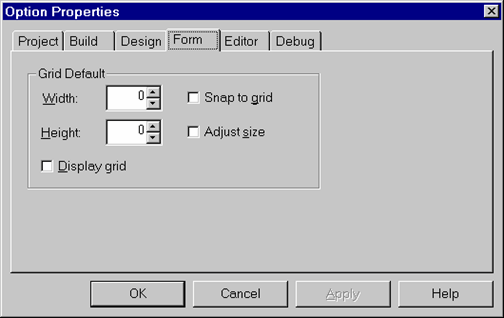
Where:
Specifies the default values to be used for the grid when you create a new form.
Specify the width and height of the grid in points, from 0 to 99.
Specifies whether to display the grid on the form.
When you select "Snap to grid", the Form Editor ensures that the upper left hand corner of a control being positioned matches a point on the grid.
When you select "Adjust size", the Form Editor ensures that, when you adjust the width or height of a control, it is an integer multiple of the grid width or height.
The figure below shows the Edit tab:
Figure 2.14 Editor Option Properties
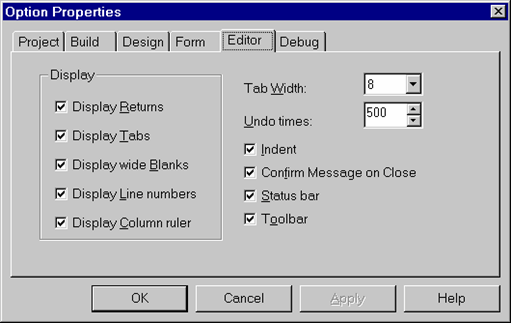
Where:
Specifies whether to display tab, line feed and em space characters in the PowerCOBOL Editor window.
Specifies whether to display line numbers and a column ruler in the PowerCOBOL Editor window.
Specifies whether tabs move to the column that is the next multiple of 4 or 8.
Tabs cannot be used for moving to the head of Area A or B.
Specifies the number of operations that can be undone using the Undo function. A very high number may affect the performance of the editor.
Specifies whether to start the next line under the first character of the previous line when the ENTER key is pressed. When Indent is not selected the cursor returns to the left-most column when ENTER is pressed.
Specifies whether to display a "Save Changes?" message when a PowerCOBOL editor window is closed and the window contained unsaved changes.
If you do not check "Confirm Message on Close", the editor saves the procedure and closes the window without displaying a confirming message.
Specifies whether or not to display the status bar at the bottom of the Editor window.
Specifies whether or not to display the Editor's toolbar.
The figure below shows the Debug tab:
Figure 2.15 Debug Option Properties
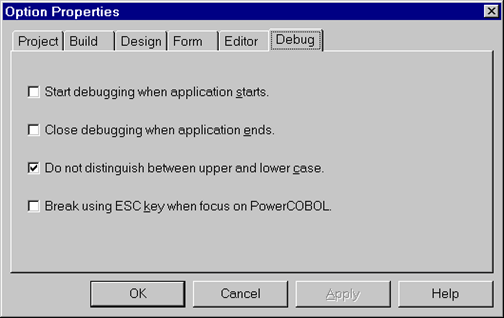
Where:
Specifies whether the debugger starts the application automatically. When checked, you can only interact with the debugger once the application has started. When not checked, you can interact with the debugger before the application starts.
Specifies whether to close debugging when the application ends.
Specifies whether to treat upper case and lower case the same when interpreting data and procedure names.
Enables the ESCape key to break execution when debugging.